One of the most interesting sailplanes at the 18th Rhoen National Soaring Contest was the Jensen two-seater, which attracted considerable notice by its beautiful appearance, as well as fine performance.
It was designed and built by E. Weber, of Rostock, who used only the best material available in its construction.
Every detail was carried out in the greatest exactness, which resulted in a saving of 132 pounds of empty weight, as compared with the well known Kranich two-seater, which has the same span and load capacity.
As with most modern, high performance sailplanes, the Jensen is a mid-wing design, with a full cantilever gull-wing. The steel wing fittings are carried through the fuselage, which is of plywood construction. Wings attachment bolts are quick locking, to facilitate assembly.
The wings have a constant chord to the gull point, where the leading edge is swept back. The aileron also extends backward, as in the Goeppingen designs. From the gull point outward, the upperside of the wings are horizontal.
The plywood on the nose is diagonal and it is doubled in thickness around the cockpit, which has a detachable cover made of Plexiglass. On either side of each cockpit is a small window, opening inward for ventilation.
The fixed horizontal stabilizer is adjustable and is held in place by three bolts.
A dep control, using what the English call the "spectacle" design, is fitted to each cockpit. A complete set of instruments includes a dash light for night flying.
There is also a Siemens communication system, for talking to the pilot of the tow plane when airplane towing.
The landing gear consists of a skid with rubber shock absorbers and detachable landing wheels, for taking off.
| Type |
Two seat high performance glider |
| Dimensions |
Length 7,0 m, height 1,65 m, span 19,0 m, wing area 22,8 m2, aspect ratio 15,85, max. width 0,6 m |
| Weights |
Empty 210 kg, max. flying weight 390 kg. wing loading 17,10 kg/m2 |
| Performance |
Max.. speed , |
| Type |
Werk.Nr |
Registration |
History |
|
|
D-2-266 |
1937. "Jensen". Took part in the 18th Rhön. Göttingen 535, Göttingen thickened in mid section, symmetrical at tip |
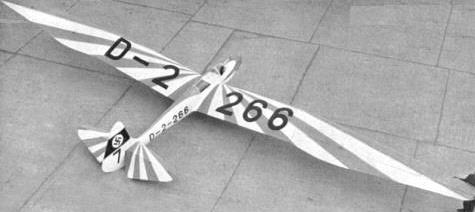
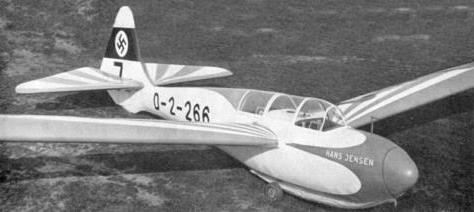
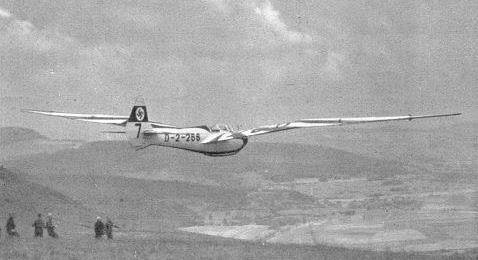
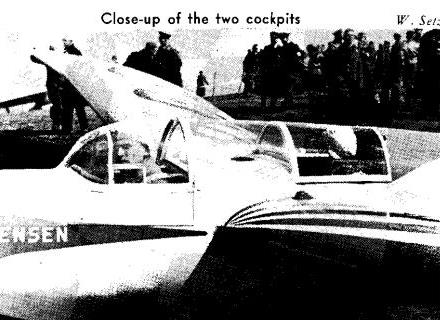
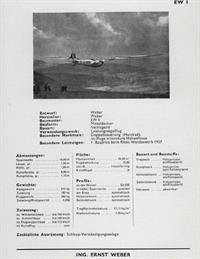
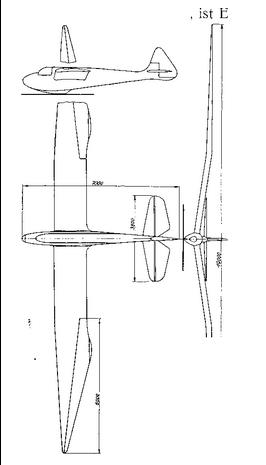

Doppelsitzer-Segelflugzeug EW 1 „Hans Jensen".
Konstrukteur der Maschine, die im diesjährigen Rhön-Wettbewerb gute Leistungen zeigte, Weber, Rostock, der auch in etwa zwei Jahren den Bau des Flugzeuges durchführte. Durch die Verwendung hochwertiger Werkstoffe und durch größte Genauigkeit in
der Herstellung konnte das Gewicht gegenüber dem bekannten Zweisitzer „Kranich" bei gleicher Flächengröße und bei gleicher Zuladung um rd. 60 kg verringert werden.
Flügel in Mitteldeckeranordnung, freitragend. Anschlußbeschlag durch den Rumpf durchgeführt, Befestigung der Flügel mit Schnell Verschluß. Kastenholm mit Kiefergurten und Diagonal Sperrholz Stegen, Kauritverleimung. Nase Diagonalsperrholz. Flügeltiefe etwa über die halbe Spannweite gleichbleibend, leichte Ffeilform, dann
Vergrößerung der Tiefe durch die nach hinten ausgebauchten Querruder mit Trimmklappen, weiterhin nach außen stark verjüngt. Am Uebergang zum Querruder Knick. Oberseite der Außenflügel horizontal.
Rumpf in Schalenbau, Spante aus Lamellen verleimt, Verstärkung durch Sperrholzdiagonalen. Zwei Hauptspante zur Aufnahme der Landekräfte, Rumpfbeplankung im Bereich der Führersitze doppelt. Windschnittige Haube aus Plexiglas, abwerfbar. In den Seitenteilen kleine Klappen zur Belüftung. Kufe aus Dural.
Freitragendes Leitwerk der üblichen Bauweise. Höhenflosse verstellbar, Befestigung am Rumpf mit drei Bolzen. Radsteuerung in beiden Sitzen. Einrichtung für Flugzeugschlepp, Siemens-Verständigungsanlage. Abwerfbares Zweirad-Fahrwerk, Kontrollampe im Qerätebrett.
Spannweite 19 m, Länge 7 m, Fläche 23 m2, Leergewicht 220 kg, Fluggewicht 400 kg, Flächenbelastung 17,4 kg/m2, Mindestsinkgeschwindigkeit 0,7 m/sec,
Fluggeschw. dabei 65—70 km/h, beste Qleitzahl 1 : 28 bei rd. 70 km/h.





